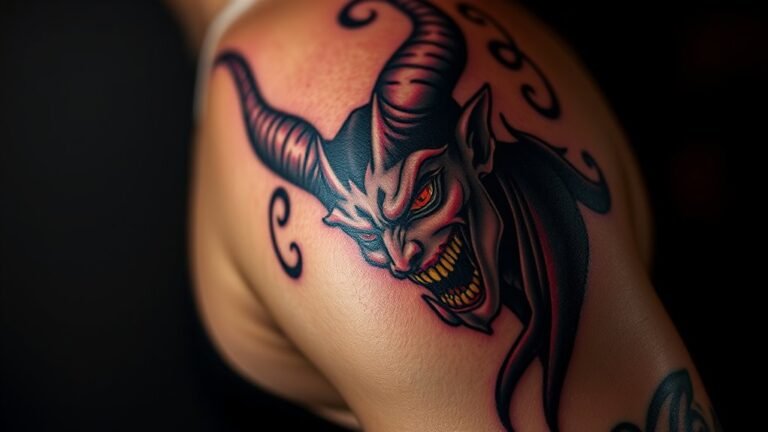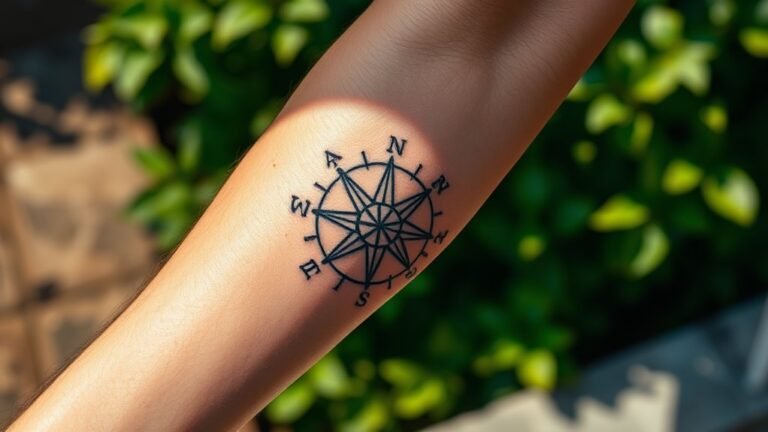Tiger Japanese Tattoo Meaning and Symbolism
When you think of a tiger tattoo, it's more than just an eye-catching design; it's a powerful symbol steeped in Japanese culture. These tattoos convey strength, courage, and protection, reflecting the fierce spirit of the tiger. Each intricate detail tells a story from mythology, where these majestic creatures guard against evil spirits. But what's the deeper connection for you? Discover how this symbolism can resonate with your own journey and choices.
In a Nutshell
- Tiger tattoos in Japanese culture symbolize power, courage, and protection, reflecting the animal's significance in mythology and tradition.
- They represent personal resilience, with each stripe signifying battles fought and the strength to overcome adversity.
- Traditional Japanese tiger tattoos often incorporate floral motifs and waves, connecting the design to cultural roots.
- Tigers serve as guardians in folklore, embodying both earthly strength and spiritual protection in various legends.
- The vibrant colors and bold lines of tiger tattoos inspire a fiery spirit, encouraging wearers to face challenges bravely.
Historical Significance of Tigers in Japanese Culture
Tigers have long roamed the domains of Japanese mythology and culture, embodying power, courage, and protection. You'll find their historical depictions woven into ancient scrolls and artistry, where they often symbolize the fierce spirit of Japan.
In tiger mythology, these majestic creatures were believed to ward off evil spirits and bring good fortune. Their striking imagery graces temples and traditional tattoos, serving as a reminder of nature's strength and the balance of life.
As you explore this cultural tapestry, you'll discover how tigers have inspired warriors and artists alike, fostering a sense of belonging through shared stories and beliefs.
Embracing the legacy of the tiger connects you to a rich history, steeped in reverence and admiration.
Symbolism of Strength and Courage
In the domain of Japanese tattoo artistry, the tiger stands as a potent emblem of strength and courage, enchanting the imagination of those who seek its wisdom. Its ferocious power resonates deeply within you, inspiring an unwavering bravery that challenges the trials life throws your way.
When you wear a tiger tattoo, you embrace not just the creature's might, but also the profound connection to resilience and determination. This symbolism serves as a reminder that, like the tiger, you can face adversity head-on, harnessing your inner strength to overcome obstacles.
The bold lines and vivid colors of the tattoo reflect your fiery spirit, forging a bond with those who share your journey, reminding you that courage lies within, waiting to be released.
The Role of Tigers in Japanese Folklore
While you may not often think about it, tigers have woven themselves into the rich tapestry of Japanese folklore, serving as both guardians and symbols of the natural world's fierce beauty.
These majestic creatures manifest in various tiger legends, often embodying strength and protection.
- Tigers as Guardians: In many tales, they stand watch over sacred spaces, warding off evil spirits.
- Mythical Creatures: Tigers transform into powerful beings, showcasing their ability to bridge the earthly and spiritual domains.
- Cultural Significance: They inspire art and literature, reflecting the deep respect for nature in Japanese culture.
Through these stories, you connect with a lineage that celebrates the tiger's essence, feeling a sense of belonging to this vibrant heritage.
Tiger Tattoos and Personal Resilience
Drawing from the deep-rooted symbolism of tigers in Japanese folklore, tiger tattoos emerge as powerful emblems of personal resilience and strength.
When you wear a tiger tattoo, you're not just displaying ink; you're embracing the fierce spirit of overcoming adversity. Each bold stripe represents a battle fought and won, a testament to your journey toward personal empowerment.
This tattoo serves as a reminder of the courage that resides within you, urging you to rise above challenges. In a world that can often feel overwhelming, a tiger tattoo connects you to a rich cultural heritage while reaffirming your commitment to face life's trials head-on.
It's a symbol of belonging, strength, and the indomitable will to survive and thrive.
Popular Tiger Tattoo Designs and Styles
Tiger tattoos come in a stunning array of designs and styles, each infused with cultural significance and personal meaning.
Whether you're drawn to the fierce power of the tiger or the grace of its movements, there's a perfect design for you. Here are some popular styles to reflect upon:
- Realistic Tiger: This design captures the intricate details of the tiger's fur and fierce expression, making it a striking choice for those wanting a lifelike representation.
- Abstract Tiger: Embracing bold colors and creative shapes, this style allows for personal expression, blending tradition with modern art.
- Traditional Japanese Tiger: Often adorned with floral motifs and waves, this design embodies strength and protection, connecting you to rich cultural roots.
Choose a style that resonates with your spirit!
Placement of Tiger Tattoos and Their Meanings
Choosing the right placement for your tiger tattoo can amplify its meaning and visual impact. Opting for areas like your back or chest allows you to showcase the majestic beauty of the tiger, symbolizing strength and courage.
A tiger tattoo on your arm or shoulder offers a bold declaration, easily visible to others, allowing you to connect with fellow tattoo enthusiasts and share its rich symbolism.
Consider visibility considerations as well; a hidden tattoo might represent a personal journey, while a prominent one can spark conversations about your beliefs and values.
Ultimately, your tiger tattoo placement should resonate with your identity, creating a sense of belonging to a community that appreciates the powerful symbolism behind this striking creature.
Caring for Your Tiger Tattoo: Tips and Considerations
Caring for your tiger tattoo is essential to confirm its vibrancy and longevity, and there are several key steps you should follow.
By adhering to these aftercare guidelines, you'll guarantee that your tattoo remains a powerful symbol of strength and resilience.
- Keep it clean: Gently wash your tattoo with mild soap and water, avoiding harsh chemicals that can fade colors.
- Moisturize regularly: Apply a fragrance-free tattoo lotion to keep the skin hydrated and promote healing.
- Avoid sun exposure: Protect your tattoo from UV rays by applying sunscreen or covering it with clothing, as sunlight can dull its beauty.
Frequently Asked Questions
What Are the Best Colors for a Tiger Tattoo?
When choosing colors for your tiger tattoo, consider vibrant color palettes. Rich oranges and deep blacks evoke strength, while gold adds a sense of prosperity. Each shade carries cultural significance, enhancing your connection to the design.
Are There Specific Cultural Taboos Surrounding Tiger Tattoos?
When considering tiger tattoos, you should respect cultural significance and adhere to tattoo etiquette. Some cultures view tigers as sacred, so you'll want to guarantee your design honors their traditions and meanings to avoid disrespect.
Can Tiger Tattoos Represent Other Meanings in Different Cultures?
Tiger symbolism varies widely across cultures, often representing strength, courage, and protection. In some traditions, these majestic creatures embody power and authority, connecting you to a rich tapestry of cultural significance and shared heritage.
How Do I Choose a Tattoo Artist for a Tiger Design?
When choosing a tattoo artist for your tiger design, explore various tattoo styles and carefully review the artist's portfolio. Look for someone whose work resonates with you, ensuring a connection that reflects your unique vision and culture.
What Is the Average Healing Time for a Tiger Tattoo?
The average healing time for your tattoo is about two to four weeks. Follow aftercare tips like keeping it clean and moisturized to guarantee a smooth healing process, embracing your new ink's vibrant journey.







